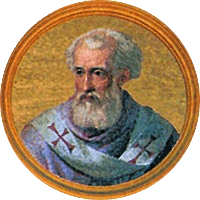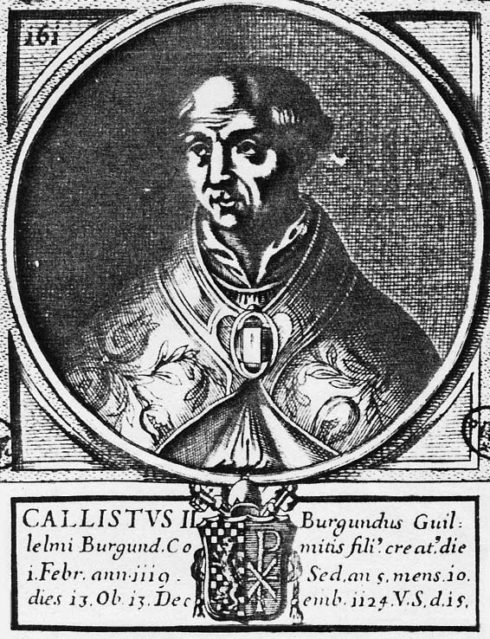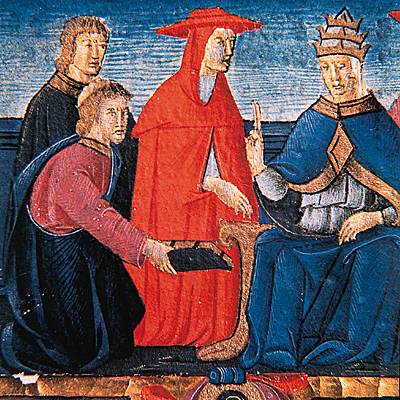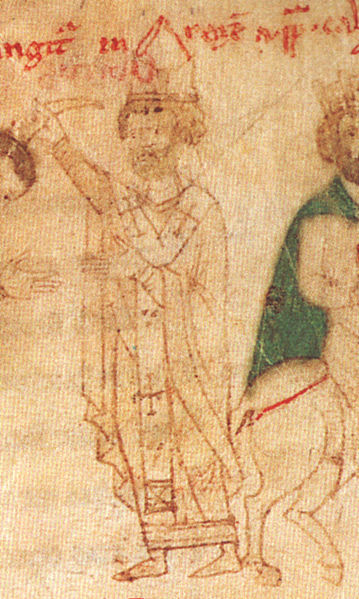Pope Callistus II
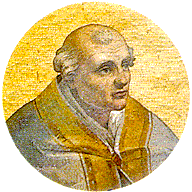 Date of birth unknown; died 13 December, 1124. His reign, beginning 1 February, 1119, is signalized by the termination of the Investiture controversy which, begun in the time of Gregory VII, had raged with almost unabated bitterness during the last quarter of the eleventh century and the opening years of the twelfth. Guido, as he was called before his elevation to the papacy, was the son of Count William of Burgundy, and both by his father’s and mother’s side was closely connected with nearly all the royal houses of Europe. His brother Hugh had been appointed Archbishop of Besancon, and he himself was named Archbishop of Vienne (1088), and afterwards appointed papal legate in France by Paschal II. During Guido’s tenure in this office, Paschal II, yielding to the threats of Henry V, was induced to issue the “Privilegium” (1111) by which he yielded up much of what had been claimed by Gregory VII, but these concessions were received with violent opposition and nowhere more so than in France, where the opposition was led by Guido, the papal legate. The latter was present at the Lateran Synod (1112), and on his return to France convoked an assembly of the French and Burgundian bishops at Vienne (1112), where the investiture of the clergy was denounced as heretical, and sentence of excommunication pronounced against Henry V because he had dared to extort from the pope by violence an agreement opposed to the interests of the Church. These decrees were sent to Paschal II with a request for confirmation, which they received in general terms, 20 October, 1112 (Hardouin, VI, 2, 1916).
Date of birth unknown; died 13 December, 1124. His reign, beginning 1 February, 1119, is signalized by the termination of the Investiture controversy which, begun in the time of Gregory VII, had raged with almost unabated bitterness during the last quarter of the eleventh century and the opening years of the twelfth. Guido, as he was called before his elevation to the papacy, was the son of Count William of Burgundy, and both by his father’s and mother’s side was closely connected with nearly all the royal houses of Europe. His brother Hugh had been appointed Archbishop of Besancon, and he himself was named Archbishop of Vienne (1088), and afterwards appointed papal legate in France by Paschal II. During Guido’s tenure in this office, Paschal II, yielding to the threats of Henry V, was induced to issue the “Privilegium” (1111) by which he yielded up much of what had been claimed by Gregory VII, but these concessions were received with violent opposition and nowhere more so than in France, where the opposition was led by Guido, the papal legate. The latter was present at the Lateran Synod (1112), and on his return to France convoked an assembly of the French and Burgundian bishops at Vienne (1112), where the investiture of the clergy was denounced as heretical, and sentence of excommunication pronounced against Henry V because he had dared to extort from the pope by violence an agreement opposed to the interests of the Church. These decrees were sent to Paschal II with a request for confirmation, which they received in general terms, 20 October, 1112 (Hardouin, VI, 2, 1916).
Guido was later, apparently, created cardinal by Pope Paschal, though the latter does not seem to have been quite pleased with his zeal in his attacks upon Henry V. On the death of Paschal II (21 Jan., 1118), Gelasius II was elected pope, but he was immediately seized by the Italian allies of Henry V, and on his liberation by the populace fled to Gaeta, where he was solemnly crowned. Henry V demanded the confirmation of the “Privilegium”, but, receiving no satisfactory reply, set up as antipope under the name of Gregory VIII, the Archbishop of Braga, Burdinus, who had already been deposed and excommunicated for having crowned Henry at Rome with the imperial crown (1117). Gelasius promptly excommunicated both the antipope and the emperor, but was himself obliged to flee, and took refuge in the monastery of Cluny, where he died (January, 1119). On the fourth day after the death of Gelasius (1 February), owing mainly to the exertions of Cardinal Cuno, Guido was elected pope, and assumed the title of Callistus II. He was crowned at Vienne (9 February, 1119).
His election was everywhere received with approbation. On account of his close connection with the royal families of Germany, France, England, and Denmark, it was hoped that he would be able to effect a favourable settlement of the controversy which had so long distracted the Church. Even Henry V received the papal embassy at Strasburg, and showed clearly that he was not unwilling to sue for peace, and at the same time he withdrew his support from the antipope. It was even agreed that pope and emperor should meet at Mousson. In 1119 (8 June) Callistus held a synod at Toulouse mainly to promote disciplinary reforms in the French Church, and in October of the same year he opened the council at Reims which had been contemplated in the preliminary arrangements made between the emperor and the papal ambassadors at Strasburg. Louis VI and most of the barons of France attended the council, which was composed of more than four hundred bishops and abbots. It had been arranged that during the council the pope and emperor were to have a personal conference at Mousson, and in compliance with this agreement Henry V arrived at Mousson, not alone, as had been anticipated, but with an army of over thirty thousand men. Callistus II left Reims to attend the conference at Mousson, but on learning of the warlike preparations made by the emperor, and fearing that force was likely to be used to extract from him prejudicial concessions, he hastily returned to Reims. Here the council busied itself mainly with disciplinary regulations, especially with decrees against investiture, simony, and concubinage of the clergy. In the end, as there was no hope of a favourable compromise with Henry, it was determined that the emperor and the antipope should be solemnly excommunicated in the presence of the assembled fathers and the representatives of the secular authority (30 October, 1119). Before leaving France Callistus tried to effect a settlement between Henry I of England and his brother Robert, but his efforts in this direction were without result.
Callistus determined to visit Italy and Rome. In the latter city Gregory VIII, supported by the German forces and the Italian allies of the emperor, had taken up his residence, but on the approach of Callistus, who was everywhere received with demonstrations of welcome, the antipope was obliged to flee to the fortress of Sutri, and Callistus entered Rome amid the universal rejoicings of the populace. He went south to secure the aid of the Normans of Southern Italy in his struggle against Henry V and Gregory VIII. The negotiations were entirely satisfactory. Gregory was taken prisoner and escorted to Rome (1121), where he was with difficulty saved from the wrath of the people, and lodged in a prison near Salerno and afterwards in the fortress of Fumo. By the aid of the princes of Southern Italy Callistus broke the power of the Italian allies of the emperor in Italy, notably of Cencio Frangipani, who had already given so much trouble to Gelasius II and to Callistus himself (1121).
Having thus established his power in Italy, he once more resolved to open negotiations with Henry V on the question of investiture. The latter had already shown that he was anxious to put an end to a controversy which had alienated from him his best friends, and which threatened to endanger the peace of the empire. An embassy consisting of three cardinals was sent by Callistus to Germany, and negotiations for a permanent settlement of the investiture struggle were begun at Wurzburg (October, 1121). Here it was agreed that a general truce should be proclaimed between the emperor and his rebellious subjects; that the Church should have free use of her possessions; that the lands of those in rebellion should be restored, and peace with the Church permanently established with the least possible delay. These decrees were communicated to Callistus II, who despatched Cardinal Lambert of Ostia as his legate to assist at the synod that had been convoked at Worms. The synod began at Worms, 8 September, 1122, and 23 September the concordat known as the Concordat of Worms (or Pactum Calixtinum) between the pope and the emperor was concluded. On his side the emperor abandoned his claim to investiture with ring and crosier and granted freedom of election to episcopal sees; on the other hand, it was conceded that the bishops should receive investiture with the sceptre, that the episcopal elections should be held in the presence of the emperor or his representatives, that in case of disputed elections the emperor should, after the decision of the metropolitan and the suffragan bishops, confirm the rightfully elected candidate, and lastly, that the imperial investiture of the temporalities of the sees should take place in Germany before the consecration, in Burgundy and in Italy after this ceremony, while in the Papal States the pope alone had the right of investiture, without any interference on the part of the emperor. As a result of this Concordat, the emperor still retained in his hands the controlling influence in the election of the bishops in Germany, though he had abandoned much in regard to episcopal elections in Italy and Burgundy.
To secure the confirmation of this Concordat of Worms, Calistus II convoked the First Lateran Council (18 March, 1123). The council was most representative, nearly three hundred bishops and six hundred abbots from every part of Catholic Europe being present. The council solemnly confirmed the agreement that had been arrived at with Henry V with regard to episcopal elections, and passed several disciplinary decrees directed against existing abuses, such as simony and concubinage among the clergy. Decrees were also passed against violators of the Truce of God, church-robbers, and forgers of ecclesiastical documents. The indulgences already granted to the crusaders were renewed, and the jurisdiction of the bishops over the clergy, both secular and regular, was more clearly defined.
In the last few years of his life, Callistus II endeavoured to secure for the Church the restoration in its entirety of the Patrimony of St. Peter, which had been greatly diminished by the constant wars and rebellions; to break the power of the nobles in the Campagna, and restore peace and order to the city of Rome itself, which had suffered much since the time of Gregory VII. He also devoted much of his time to the interests of the Church of France and to combating the errors and abuses which made their appearance in that country in his time. In the Synod of Toulouse (1119) he condemned the teaching of Peter de Bruis and his followers (Hardouin, VI, 2, 1977-84). He established the Church of Vienne as the metropolitan church of the adjoining ecclesiastical provinces (1120), thereby ending in favour of the former (that he still held as pope) the ancient controversy between Vienne and Arles. For the privileges in favour of Vienne forged during the reign of Guido, see Gundlach, “Streit der Bisthumer Arles und Vienne” (1890). Duchesne maintains (“Fastes Eccl.”, I, 145 sqq.) that only the more recent of them date from the time of Guido (cf. Robert, “Calixte II”, Paris, 1891). He settled several disputes between bishops and abbots in France, dispatched Gerard of Angouleme as papal legate to Brittany, and finally confirmed the primatial rights of Lyons over the Church of Sens. He demanded of Henry I of England the release of his brother, Robert of Normandy, as well as the acknowldgment of Thurstan, whom he himself had consecrated at Reims, as Archbishop of York. Henry at first refused, but on the threat of excommunication he consented to admit Thurstan as Archbishop of York, and to acknowledge the latter see’s independence of Canterbury. In Spain he transferred the metropolitan rights from the old see of Merida (Emerita) to Santiago de Compostella, to the patron saint of which Callistus seems to have had a special devotion. He showed his attention to Germany by the canonization of Conrad of Constance at the Lateran Synod (1123) and by dispatching Otto of Bamberg as papal legate to regulate the Churches of Pomerania. In Rome he devoted much attention to beautifying and improving the city, but especially the church of St. Peter. He suppressed the suburban See of Santa Rufina by uniting this diocese with Porto, so that thenceforth there were only six cardinal-bishops instead of seven as had formerly been the case.
Callistus died in 1124, and after some dipute Honorius II was selected as his successor. As to the great influence of the reign of Callistus II on the policy of the Church there can be no dispute. Owing mainly to him the concessions so weakly made by Paschal II were recalled, and on his own accession to the papal throne, his firmness and strength of character secured a settlement of the controversy between Church and State which, though not entirely satisfactory, was at least sufficient to assure a much needed peace. Through his exertions he put an end to the wholesale bestowal of ecclesiastical offices by laymen; he re-established the freedom of canonical elections and secured recognition of the principle that ecclesiastical jurisdiction can come only from the Church, while on the other hand he conceded to the secular authorities the influence to which they were rightly entitled in the election of prelates who were at the same time the most powerful and richest subjects of the State. On the other hand, he was blamed at the time, principally by Archbishop Conrad of Salzburg, for not insisting upon the withdrawal of the oath of homage which every bishop was required to make to the emperor or his feudal lord, but it should be remembered that Callistus II well understood that unless something were conceded peace was impossible, and that the oath of homage, however improper the ceremony might seem, was not an unnatural demand on the part of the emperor in regard to subjects who wielded such an enormous political power as did the bishops of the German Empire.
Callistus II was not very remarkable for his literary productions; yet a few works have come down to us which are ascribed to his pen. They are: “De Miraculis Sancti Jacobi Apostoli”, “De obitu et Vita Sanctorum”, “Vita Caroli Magni Imperatoris”. Many letters attributed to him are preserved. These, together with his other writings, may be found in Migne, P.L., CLXIII (1073-1383). Besides this edition, thirty-six of his letters are contained in Hardouin’s “Concilia” (VI, 2, 1949-1976). These same letters, with two additional, are published by Mansi (XXI, 190-218); some others are given by D’Achery [Spicilegium (Paris, 1723), II, 964; III, 478, 479]; some additional ones are to be found in “Magn. Bull. Rom. Continuat.”, III, ed. Luxembourg, 1730, 12.
Biographies of Callistus II have been written by PANDULPHUS ALETRINUS, ARAGONIUS, and BERNARDUS GUIDONIS (MURATORI, Script. Rer. Ital., III, 1, 418). Cf. WATTERICH, Vitae Rom. Pontif., II, 115; MIGNE, P.L., CLXIII, 1071; ROBERT, Bullaire du pape Calixte II (Paris, 1891); MAURER, Papst Calixtus II, in 2 parts (Munich, 1886, 1889). For the Synod of Vienne, see MANSI, XXI, 175, and HARDOUIN, VI, 2, 1752. For the Synod of Reims, MANSI, XXI, 187, and HEFELE, Conciliengesch., V, 344; HALLER, Die Verhandlungen zu Mouzon (1119), etc. in Heidelberger Jahrbucher, 1892. For Concordat of Worms, see MANSI, XXI, 273, 287, and JAFFE, Bibl. Rer. Germ., V, 383, also MUNCH, Vollstandige Sammlung aller Concordate, I (Leipzig, 1830), and NUSSI, Conventiones de Rebus Eccles. (Mainz, 1870); BERNHEIM, Zur Geschichte des Wormser Konkordates (Leipzig, 1878); BRESLAU, Die kaiserliche Ausfertigung des Wormser Konkordates in Mitteil. des Instituts fur Oesterreich. Gesch., 1885.
JAMES MACCAFFREY (Catholic Encyclopedia)
